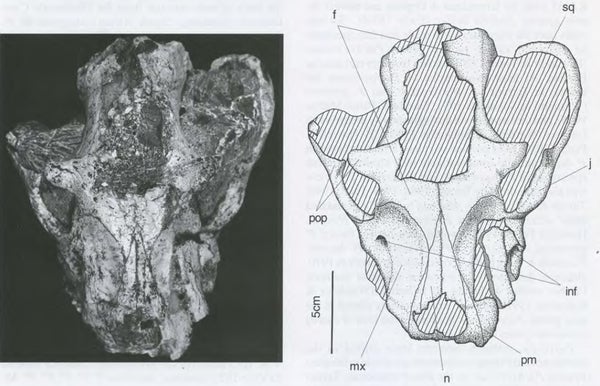This article was published in Scientific American’s former blog network and reflects the views of the author, not necessarily those of Scientific American
I started the weekly Paleo Profile to highlight new fossil species as they step out onto the scientific stage. But this week I'm doing something a little different. I'm going back to an animal whose remains have been known to us for over a century and a half and that our prehistoric relatives certainly had to contend with in life. I'm talking about the largest hyena of all time, Pachycrocuta brevirostris.
The scientific trail of this huge hyena picked up in 1845. It was in that year that French paleontologist Auguste Aymard found the carnivore's cranium in the region of Le Puy. From there the origin of the hyena's name is tangled enough that it required an entire paper by David Alba and colleagues to straighten it out, but suffice it to say that 19th century paleontologists were impressed by the size and pug-nosed appearance of the beast. They dubbed it the short-faced hyena.
But the discovery of Pachycrocuta brevirostris was really only a rediscovery. The species evolved before 3 million years ago, the earliest appearances in Africa and Asia being nearly simultaneous, and it chewed its way into Europe by about 2 million years ago. This was around the same time that prehistoric humans were blazing trails around the planet, too, and we know that they met this hefty hyena. Signs of both humans and Pachycrocuta surround a fossil elephant carcass in Spain, and more than half the Homo erectus bones from China's famous Dragon Bone Hill showed gnaw marks that demonstrated how effective these carnivores were at dismantling human bodies.
If anyone ever made artistic or cultural depictions of Pachycrocuta, they've never been found. What we've got is the osteology of the beast. This was a truly massive hyena, as heavy as a lion. But it wasn't just like a modern hyena writ large. The short-faced hyena was only about as tall as today's spotted hyena, meaning it was a burly, stocky carnivore that would have looked lower-slung than its modern relatives. This might indicate, as paleontologist Paul Palmqvist and others have argued, that Pachycrocuta was a scavenging specialist, best suited to ripping heavy pieces of carrion off carcasses before trotting back to the den to consume them. However Pachycrocuta acted, though, it must have cut an imposing figure on the prehistoric landscape. A hyena capable of easily crushing a human skull is not one to be trifled with.

A skull of Pachycrocuta brevirostris from South Africa. Credit: Mutter et al. 2001
Fossil Facts
On supporting science journalism
If you're enjoying this article, consider supporting our award-winning journalism by subscribing. By purchasing a subscription you are helping to ensure the future of impactful stories about the discoveries and ideas shaping our world today.
Name: Pachycrocuta brevirostris
Meaning: Pachycrocuta means "thick hyena", while brevirostris refers to the carnivore's short snout.
Age: Pliocene to Pleistocene, 3 to 0.5. million years ago.
Where in the world?: Africa, Europe, and Asia.
What sort of critter?: A hyena.
Size: As heavy as a lion but only as tall as a modern spotted hyena.
How much of the organism’s body is known?: Hundreds of skeletal elements from multiple fossil sites through the Old World.
Reference:
Alba, D., Vinuesa, V., Madurell-Malapeira, J. 2015. On the original author and year of description of the extinct hyaenid Pachycrocuta brevirostris. Acta Palaeontologica Polonica. doi: 10.4202/app.10.4202/app.00017.2013
Mutter, R., Berger, L., Schmid, P. 2001. New evidence of the giant hyaena, Pachycrocuta brevirostris (Carnivora, Hyaenidae) from the Gladysvale Cave deposit (Plio-Pleistocene, John Nash Nature Reserve, Gauteng, South Africa). Palaeontologia Africana. 37: 103-113
Palmqvist, P., Martínez-Navarro, B., Pérez-Claros, J., Torregrosa, V., Figueirido, B., Jiménez-Arenas, J., Espigares, M., Ros-Montoya, S., De Renzi, M. 2011. The giant hyena Pachycrocuta brevirostris: Modelling the bone-cracking behavior of an extinct carnivore. Quaternary International. doi: 10.1016/j.quaint.2010.12.035
Previous Paleo Profiles:
The Light-Footed Lizard The Maoming Cat Knight’s Egyptian Bat The La Luna Snake The Rio do Rasto Tooth Bob Weir's Otter Egypt's Canine Beast The Vastan Mine Tapir Pangu's Wing The Dawn Megamouth The Genga Lizard The Micro Lion The Mystery Titanosaur The Echo Hunter The Lo Hueco Titan The Three-Branched Cicada The Monster of Minden The Pig-Footed Bandicoot Hayden's Rattlesnake Demon The Evasive Ostrich Seer The Paradoxical Mega Shark The Tiny Beardogs The Armored Fish King North America's Pangolin The Invisible-Tusked Elephant The Mud Dragon The Spike-Toothed Salmon The Dream Coast Crocodile Buriol's Robber Ozimek's Flyer The Northern Naustoceratopsian The High Arctic Flyer The Tomatillo From the End of the World